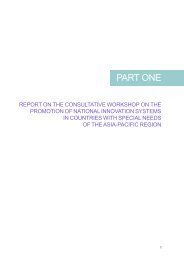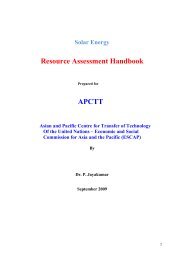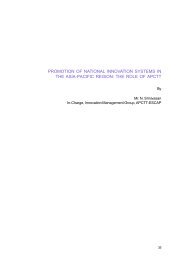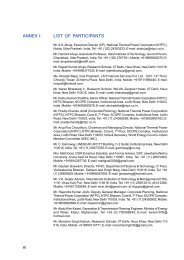and other financial institutions – such as the Life Insurance Corporation of India (LIC)and Employees’ Provident Fund Organization (EPFO) – bearing the remaining 15.4per cent. State Electricity Boards account for 46.1 per cent of loan outstanding.Sector/environment concerns have made financiers proceed with caution: some largedevelopers have multiple projects under construction and the leverage has increased.Financiers are wary of lending further without enhancement in equity base. Powersector concerns that are under sharp focus include domestic coal shortage, worrisomestate of utility finances, continuing dip in the short-term price of electricity, and risingcommodity prices and borrowing costs with fixed price contract for sale of electricity.Financiers are therefore bound to exercise more caution, although this need not be abarrier and could help bring the focus back on improving the preparedness of projectsfor financing as well as on addressing fundamental underlying factors impacting thesector’s sustainability.Financing for advanced technologies has its own characteristic requirements, andhaving a policy road map for supporting advanced technologies is a basic requirement.The framework must have cost reduction/commercialization roadmap. Until technologytransits into being baseline, commercial finance will be difficult to harness. Governmentwill have to play a leading role to develop projects and multilateral/bilateral financialinstitutions could be tapped to part-finance such projects. In the R&D/demonstrationphase, state and central public sector units (PSUs) will have to play an important roleand provide upfront capital subsidies/grants to avoid burdening distribution utilities.Summing up the discussions, Mr. Kirit Parikh, former Member of Planning Commission,opined that the independence of the regulator is a must to attain preferable conditionsfor motivating finance from the market. The regulator should carefully device and adviceon the tariff plan so that the utilities and Discoms have appropriate operational marginsand are self-dependent. Coal imports to inland sites are a nightmare in view of thetransportation linkage from port and the transportation arrangements, and these addto the price of the coal. Trading imported coal involves transaction costs that need tobe covered. Fluctuations in the international prices of coal have also caused a majorconcern. It is essential to improve the efficiencies of indigenous coal mining and tomake major efforts in underground coal mining. It is not sufficient to focus only on coalcombustion technologies that will help reduce the emissions; the quantity of coalavailable also needs to be improved.The Integrated Energy Policy had made 122 recommendations out of which 40 havebeen implemented thus far, another 40 are in a state of possible implementation, andthere is an agreement on 20 recommendations that may be followed. However, there isno agreement among different ministries on the implementation of the remaining 22recommendations. It is for the government now to consider whether the energy policyneeds to be revisited.FSession V: Panel discussion on development of power sectorwith reference to advanced FFTsThe Session was chaired by Mr. V. Raghuraman, former Principal Adviser (Energy),CII. Following were the panellists:24
• Mr. Pradeep Chaturvedi, Consultant, APCTT-ESCAP, and Vice-Chairman (Energy),World Federation of Engineering Organization;• Mr. J.K. Mehta, Regional Manager, World Energy Council;• Prof. S.S. Murthy, Consultant, APCTT-ESCAP, and Professor, Electrical EngineeringDepartment, IIT Delhi; and• Mr. Shekhar Kumar, Assistant Director, CPRI.Mr. V. Raghuraman described that investment needs for the power sector in the 12 thFYP is estimated at US$265 billion to add 90,000 MW of new capacity along withattendant transmission and distribution facilities. 7 Mobilizing funds of this magnitudewould require:• Timely revision of tariffs by states to make Discoms viable and bankable;• Effective linkages of coal and gas for existing capacity and likely additions, andfacilitating PPAs to enable banks to make provision to lend to the sector;• Increased production by CIL on its own or through joint ventures, and ensuring thatcaptive coal mine development issues are resolved;• Resolving the current imbroglio on imported coal prices being not a ‘pass through’for tariff considerations;• Building 100 km railway corridors in Odisha, Chattisgarh and Jharkhand to movecoal freely from pithead to railhead;• Fixing price for a blend of local coal and 15 per cent imported coal to insulateconsumers from tariff shocks;• Overcoming the fear on the part of private investors about non-performing assets(NPAs) through rational changes in NPA norms; and• Removing major irritants to FDI such as retrospective punitive measures.Technology development will need to consider the following:• Clean Energy Fund accumulated with a cess of Rs 50 per tonne of coal should beused for flagship R&D programmes and demonstration projects;• Like the BHEL/NTPC/IGCAR consortia development project on ultra-supercriticaltechnology, consortia could be developed for using CFBC technologies for washerymiddling, washability and blending of coals, IGCC etc., and the involvement ofacademics needs to be encouraged;• Renewable technologies such as advanced solar photovoltaic material, solar thermal,biofuels and low-speed wind generators need development;• Dissemination of information among the public on the role of technologies to shiftto a low-carbon economy is essential; and• Energy efficiency efforts – such as energy labelling, Perform, Achieve and Trade(PAT) scheme, Energy Conservation Building Code and BEE’s fuel efficiency normsfor cars – need further support, notably the PAT scheme that will give a fillip torenovation/modernization programme of thermal power stations and acceleratephasing out of inefficient units.Mr. Pradeep Chaturvedi focused on the need for planned development of the powersector by creating a special purpose vehicle to facilitate all clearances before theprojects are tendered out. While there is an urgent need to move over to supercritical7See footnote 2 on page 5 regarding variation in figures.25
- Page 1 and 2: ADVANCES IN FOSSIL FUELTECHNOLOGIES
- Page 3 and 4: ADVANCES IN FOSSIL FUELTECHNOLOGIES
- Page 5 and 6: CONTENTSABBREVIATIONSiiiPART ONEREP
- Page 7 and 8: ABBREVIATIONSAC : Alternating curre
- Page 9: OECD : Organization for Economic Co
- Page 12 and 13: IORGANIZATION OF THE WORKSHOPA. Bac
- Page 14 and 15: D. Election of officersThe followin
- Page 16 and 17: IIICONSIDERATION OF ISSUESA. Backgr
- Page 18 and 19: emissions. Underground coal gasific
- Page 20 and 21: 800 MWe, a steam pressure of 300 kg
- Page 22 and 23: • Materials development & manufac
- Page 24 and 25: Figure 1-5: Strategy for commercial
- Page 26 and 27: tonnes, the state-owned enterprise
- Page 28 and 29: • Ensuring not just easy FDI entr
- Page 30 and 31: MW ultra-supercritical units; and s
- Page 32 and 33: the captive generation capacity) on
- Page 36 and 37: and higher efficiency power generat
- Page 38 and 39: energy technologies, which can enab
- Page 40 and 41: • Such massive financial inputs c
- Page 43 and 44: BASELINE REPORT ON FOSSIL FUEL TECH
- Page 45 and 46: B. General R&D climate in the count
- Page 47 and 48: a convenient way to envisage energy
- Page 49 and 50: to mature and become more cost-comp
- Page 51 and 52: emissions, at least relative to sin
- Page 53 and 54: The Ministry of Power (MoP), which
- Page 55 and 56: 3. Bio-energyBio-energy, widely ava
- Page 57 and 58: in such a canal will rotate at a lo
- Page 59 and 60: in tackling climate change. A one p
- Page 61 and 62: Advantages of supercritical plants
- Page 63 and 64: existing power plants but also to b
- Page 65 and 66: BASELINE REPORT ON FOREIGN DIRECT I
- Page 67 and 68: CEA at 598 mt. This is mainly due t
- Page 69 and 70: For India to maintain its momentum
- Page 71 and 72: Table 2-5: Electricity generation t
- Page 73 and 74: Growth, which submitted its interim
- Page 75 and 76: 3. Future challengesThe future chal
- Page 77 and 78: development worked out. Public-priv
- Page 79 and 80: Linking FDI to technology transferI
- Page 81 and 82: The total requirement of fund durin
- Page 83 and 84: Funding from multilateral agenciesM
- Page 85 and 86:
cooperation will be essential in so
- Page 87:
Planning Commission, Government of
- Page 90 and 91:
ANNEX I:LIST OF PARTICIPANTSMr. A.K
- Page 92 and 93:
Mr. S.C. Shrivastava, Joint Chief (
- Page 94 and 95:
ANNEX II:PROGRAMME6 June 2012, Wedn
- Page 96 and 97:
ANNEX III:AN OVERVIEW OF ADVANCED F
- Page 98 and 99:
• Technology solutions are also v
- Page 100 and 101:
Table 3-5: Improvement in cycle eff
- Page 102 and 103:
• No liquid effluent formation;
- Page 104 and 105:
Figure 3-5: Advancement of gas turb
- Page 106 and 107:
Figure 3-8: Goal 2 - New clean tech
- Page 108 and 109:
Compared with conventional power pl
- Page 110 and 111:
Figure 3-14: Thermax coal gasificat
- Page 112 and 113:
ANNEX VII:GE ENERGY AND ADVANCED FO
- Page 114 and 115:
ANNEX VIII:SWOT ANALYSIS OF FOSSIL
- Page 116 and 117:
By 2035, cumulative CO 2emissions f
- Page 118 and 119:
• Falling prices of renewable ene
- Page 120 and 121:
Figure 3-20: New advanced coal powe
- Page 122 and 123:
ANNEX X:ENERGY CONSERVATION: ERDA
- Page 124 and 125:
Table 3-11: Energy cost and intensi
- Page 126 and 127:
300Figure 3-23: Trends in coal use
- Page 128 and 129:
C. Gaps in coal use efficiencyFigur
- Page 130 and 131:
ANNEX XII:FINANCING OF THE POWER SE
- Page 132 and 133:
With the entry of many private sect
- Page 134 and 135:
for future requirements should be t
- Page 136 and 137:
Short supply of coal has started af
- Page 138:
Figure 3-35: Life-cycle of technolo







